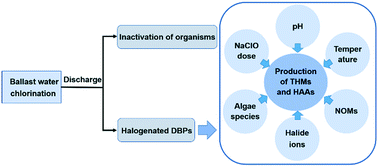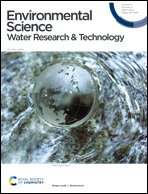Formation of halogenated disinfection by-products during ballast water chlorination†
Abstract
Halogenated disinfection by-products (DBPs) from ballast water treatment have attracted more attention owing to their potential threats to marine ecosystems. Chlorination is widely used in ballast water treatment, in which the production of DBPs should not be ignored. In this work, the bioavailability of ballast water chlorination was investigated, and the formation of trihalomethanes (THMs) and haloacetic acids (HAAs) during ballast water treatment was explored. Different holding times, pH values, temperatures, NaClO doses and algae species affected the bioavailability of chlorination. A positive correlation was found between total residual oxidant (TRO) consumption and the formation of halogenated DBPs. The increase in the holding time promoted the production of THMs and HAAs. An increase in pH from 4 to 10 improved the production of THMs but restrained the generation of HAAs. An increase in temperature facilitated the formation of THMs and HAAs. The concentration of bromine and iodide have a positive contribution to the production of THMs, and bromine had an impact on the component of HAAs rather than the production of HAAs. NOMs affected the formation of THMs and HAAs and humic acid contributed more DBPs than the algae in disinfected ballast water.



 Please wait while we load your content...
Please wait while we load your content...